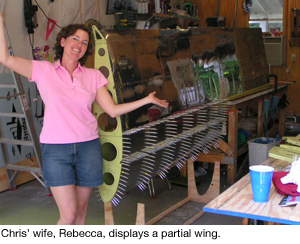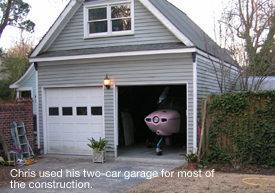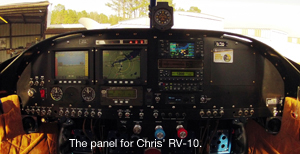Chris Lucas' RV-10 By David Gustafson
|
Chris Lucas recently finished his RV-10 project, has logged 13 hours in it and is thrilled with the outcome. He enjoyed the building so much that he’s thinking of building another tail section just for the fun of it (he’d sell it when completed). Between the day he first saw the RV-10 at Oshkosh 2003, which prompted him to write out a check for serial number 72, and his first flight on November 27, 2011, a little over 8 years elapsed. Chris grew up with an admiration for all things “aviation”. He did models, earned his private in college, where he got a degree in Aerospace Engineering, hired on with the Navy, and later entered a partnership on a C-35 Bonanza. That worked well until he took it in for an annual by some people he didn’t know. The whopping price of that annual got him thinking about finally building his own airplane. He had been fascinated by Burt Rutan’s creations with composites and really liked the performance of the Lancairs, but the price of the kits kept shooting up which put him off. For a while he focused on the Murphy Super Rebel. In the end, cost, performance and a growing family drove him to select the RV-10.
Chris has a two-car garage that became his workshop. With help from his wife, whom he identifies as “the Enabler”, his father, Robert, and friends Bill Hood and Robert Montidonica, CFI, A&P, IA, he made steady progress. As Vans Aircraft has done repeatedly, there were a total of five kits. The first, a tail kit, included everything from the baggage compartment aft. That section took Chris about a year to complete. Several months later the wing kit arrived and he tackled the spars, ribs and covering material (all aluminum). The third kit was for the cabin. The fourth consisted of engine mount, gear and cowlings. The final included the engine and prop. The doors and cabin top are made out of composites which gave Chris the greatest challenge. Getting everything to fit flush and line up properly along with installing the windows took considerable time and effort. He was much happier working with the aluminum components. They were pre-aligned.
Chris made two changes to the design. They’re minor enough that he likely won’t incur the wrath of the factory, which disdains mods of any kind. The first was a compromise with the mean temperatures at his home in New Bern, North Carolina. He mounted a ceiling panel with lights and created an air vent, using a Bonanza part. He also did away with the piano hinge that was to be mounted on the outside for the baggage door, substituting hidden hinges.
On the day of his first flight, “I was super nervous.” A couple months prior, Chris had gone out to Oregon to log 9 hours of transition training in the factory’s RV-10. That experience allowed him to keep his cool. As he lifted off, the fear vanished. “Landings are non-events. With the break-in for the engine I’ve been running it at 24-squared and I’m getting 165 knots in cruise.” He has a Lycoming IO-540D4A5, 260hp in the front office. His panel is mainly Grand Rapids Technology EFIS and Garmin products.
“The project was a good idea and I’m glad I did it. It feels funny to be an airplane owner again…sometimes it feels surreal.”
For more information on theRV-10 visit www.VansAircraft.com. |




 The holes for rivets had been punched for the ribs and skins at the factory. He simply had to enlarge the holes, debur them, insert clecos, and then begin replacing the clecos with rivets. There was very little fabrication; most of it having been done at the factory, and the instructions/plans, according to Chris were like an RC model, with step by step, check-it-off instructions and three view drawings to assist. He estimates that he made no more than 10 phone calls to the factory for builder assistance.
The holes for rivets had been punched for the ribs and skins at the factory. He simply had to enlarge the holes, debur them, insert clecos, and then begin replacing the clecos with rivets. There was very little fabrication; most of it having been done at the factory, and the instructions/plans, according to Chris were like an RC model, with step by step, check-it-off instructions and three view drawings to assist. He estimates that he made no more than 10 phone calls to the factory for builder assistance. Though he fretted and worried about the wiring, after some reading, online chats and discussions with friends, it turned out to be one of his most satisfying experiences.
Though he fretted and worried about the wiring, after some reading, online chats and discussions with friends, it turned out to be one of his most satisfying experiences. 


